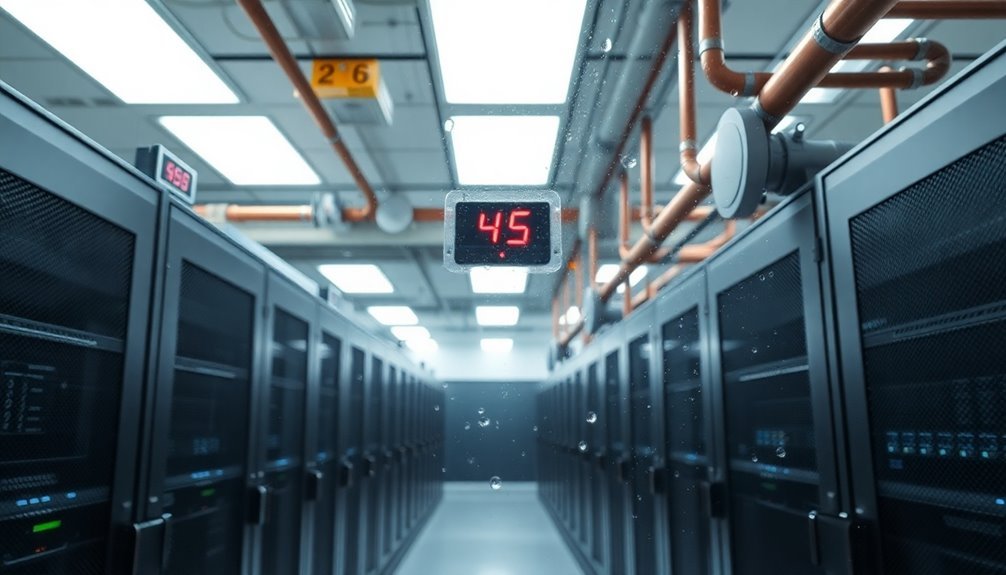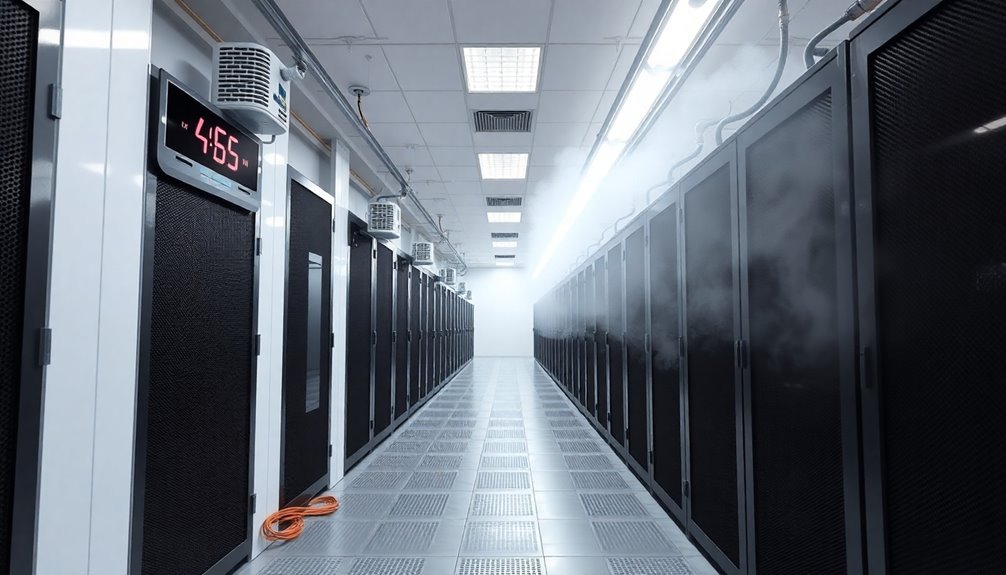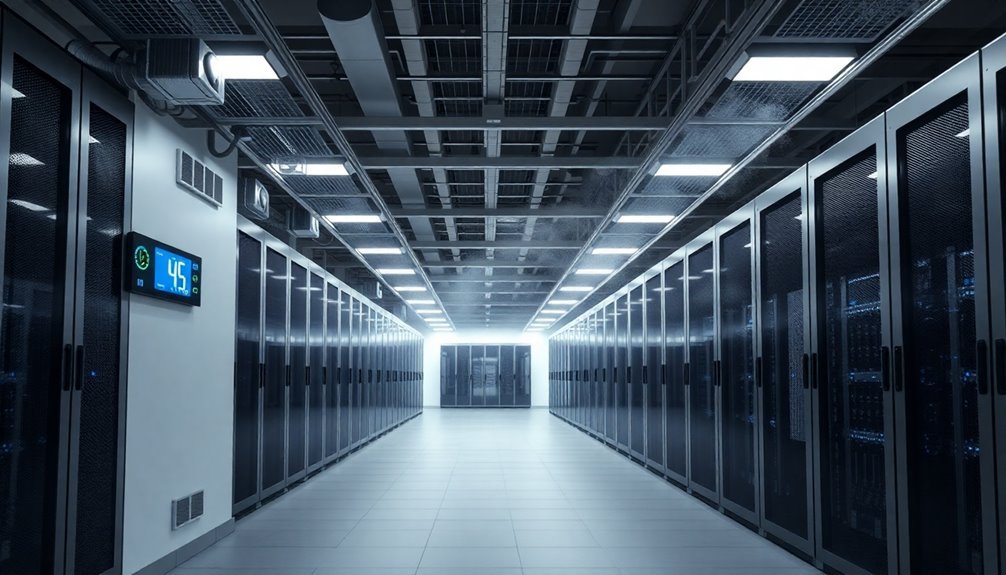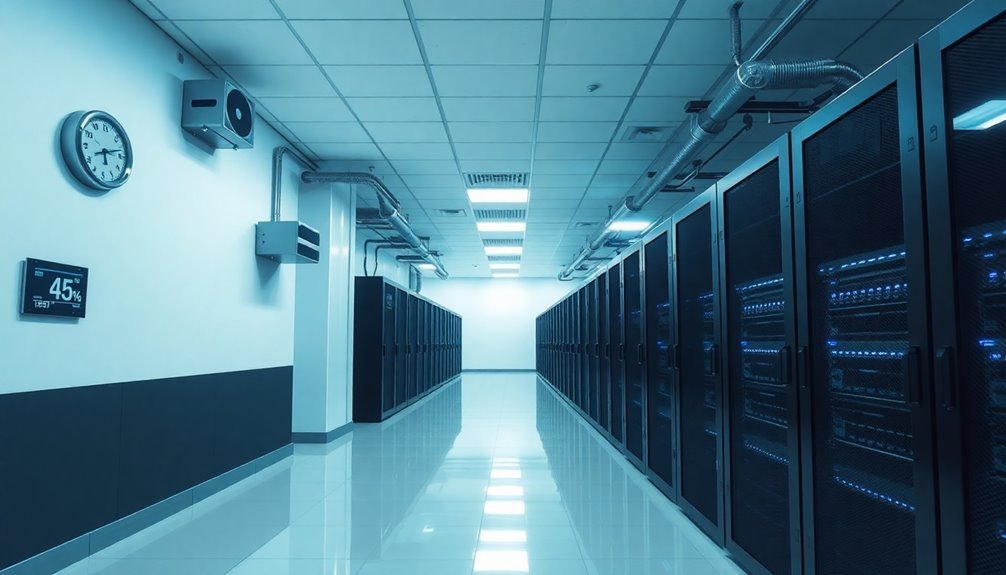To keep your computer room static-free, you'll need to maintain relative humidity levels between 30-40%. This ideal range prevents electrostatic discharge (ESD) that can damage sensitive electronics. You can achieve these levels using ultrasonic humidifiers or advanced humidification systems with real-time monitoring capabilities. Maintaining the correct humidity is crucial to install humidity sensors at various heights in your server racks and implement continuous monitoring through DCIM software. Proper ventilation management and ESD-compliant equipment, like anti-static flooring and ionizers, will further protect your valuable hardware. Understanding the complete humidity control strategy can help you create the safest environment for your equipment.
The Science Behind Static Electricity

Static electricity emerges out of a fundamental process called the triboelectric effect, where electrons transfer between materials through contact and friction. When you touch or rub two materials together, electrons can jump from one surface to another, creating an imbalance of charges. One material gains electrons and becomes negatively charged, while the other loses electrons and becomes positively charged.
You'll notice that different materials have varying tendencies to attract or release electrons, which determines how readily they'll generate static electricity. This process becomes particularly significant in computer rooms, where repeated contact between materials can lead to substantial static buildup. The phenomenon is similar to laser printers and photocopiers that utilize static electricity to precisely position toner on paper.
The charge imbalance continues until it finds a path to discharge, often resulting in those unexpected shocks you might experience.
Temperature changes can complicate matters through the pyroelectric effect, making static control even more challenging in climate-controlled environments. Without proper management, this buildup of static electricity can pose serious risks to your electronic equipment.
The discharge of static electricity, even in small amounts, can damage sensitive computer components and potentially compromise your data center's functionality.
Optimal Humidity Levels For Electronics
You'll find that maintaining proper humidity levels is essential for protecting your computer room equipment, with experts recommending a relative humidity range of 30-40%. This sweet spot helps prevent static electricity buildup while avoiding moisture-related issues that could damage sensitive electronics. Implementing real-time monitoring systems allows for dynamic adjustments to maintain optimal conditions throughout the day.
Your facility's humidity control system should actively maintain these levels to guarantee both ideal equipment performance and workplace safety.
Humidity Range For Safety
Safety in electronic environments hinges on maintaining precise humidity levels, with recommended ranges between 30% and 70% relative humidity (RH).
You'll want to keep your computer room's humidity levels between 30% and 40% to minimize both ESD risks and condensation issues that could damage your equipment. Moisture vapor circulation in the air affects how electronic devices function and their overall longevity.
If you let humidity drop below 30%, you're increasing the risk of electrostatic discharge, which can seriously damage electronic components and create safety hazards for your staff.
On the flip side, letting humidity climb too high invites condensation problems that can lead to short circuits and corrosion in your valuable equipment.
To maintain a safe environment, you'll need to monitor humidity levels consistently. When you keep levels around 40% RH, you're creating ideal conditions for ESD prevention by lowering surface resistance.
This sweet spot also helps protect moisture-sensitive components and guarantees proper functioning of PCB assemblies.
Remember that proper humidity control isn't just about equipment protection – it's also essential for maintaining a safe work environment by reducing the risk of fires and explosions caused by static electricity.
Static Control Sweet Spot
Finding the perfect humidity balance for electronics requires precision, with 40% relative humidity (RH) emerging as the ideal sweet spot for static control.
While the safe operating range spans from 30-60% RH, you'll want to aim for 40% RH to enhance your computer room's static protection. This level provides the best balance between preventing electrostatic discharge (ESD) and avoiding moisture-related issues. Precision humidifier systems can help maintain these optimal conditions consistently.
You'll notice that when humidity drops below the sweet spot, static electricity becomes a significant concern. The dry air creates conditions where static charges build up more easily, increasing the risk of ESD damage to your sensitive electronic components.
On the flip hand, if you let humidity climb too high, you're risking condensation and potential corrosion of your equipment.
To maintain this ideal level, you'll need precise control mechanisms. Consider installing automated HVAC systems with continuous monitoring capabilities. These systems can adjust humidity levels in real-time, keeping your computer room within the ideal range.
For maximum protection, you should also implement humidity sensors throughout your space to identify and address any micro-climate variations that could affect your equipment's safety.
Effective Humidification Control Methods

With proper implementation, humidification control in computer rooms requires a balanced approach combining the right technologies and strategies. You'll find ultrasonic humidifiers and spray systems are among the most energy-efficient options, while steam boilers and gas-fired systems consume more energy.
You can substantially improve efficiency by measuring humidity using dew point instead of relative humidity (RH). This switch alone has reduced humidification run-time from 80% to 20% in ENERGY STAR certified data centers. Using dew point measuring devices provides the highest accuracy for calibrating your humidity control systems.
To prevent "CRAC fighting," turn off individual CRAC unit humidification controls and designate a single unit as your central humidifier.
Your target should be maintaining relative humidity between 30-40% to prevent both ESD failures and condensation risks. You'll want to implement sophisticated temperature and humidity monitoring systems while considering using waterside economizers for energy-efficient moisture control.
Don't forget to address building infrastructure – install vapor barriers in walls and ceilings, fix wet basement walls, and eliminate standing water. These measures will minimize external moisture influences and help maintain ideal conditions for your computer room equipment.
Data Center Humidity Management
Building on effective humidification control methods, modern data centers require sophisticated humidity management strategies to maintain ideal operating conditions. You'll need to implement continuous monitoring systems using strategically placed sensors and DCIM software to track and adjust humidity levels in real-time. For optimal moisture control, maintain the dew point above 5.5°C to prevent static electricity buildup.
| Control Aspect | Key Action | Benefit |
|---|---|---|
| Temperature | Monitor air at equipment intake | Prevents hot spots |
| Ventilation | Minimize fresh air supply | Reduces humidity fluctuation |
| CRAC Systems | Switch to supply air control | Maintains constant conditions |
To enhance your humidity management, you'll want to follow ASHRAE guidelines for relative humidity and dew point control. Place sensors in every fifth rack and near critical equipment to detect variations quickly. You can prevent moisture-related issues by setting up alert thresholds and implementing predictive adjustments based on sensor data.
Don't overlook the energy efficiency aspects of humidity control. You can reduce operational costs by raising cooling set points and utilizing free cooling when possible. Consider integrating IoT devices and AI-driven systems for advanced control, allowing you to maintain ideal conditions while minimizing energy consumption and water usage.
Static Prevention Equipment

Effective static prevention equipment stands at the forefront of protecting sensitive computer room components from electrostatic discharge (ESD) damage. You'll need to implement several key tools to create a thorough static protection system.
Start with proper ESD flooring, which provides a vital conductive path to ground. You can choose from static-dissipative carpet, ESD tiles, or anti-static floor paint, but make sure they don't require special maintenance sprays for effectiveness. ESD damage can weaken components gradually even when immediate failure is not apparent.
Complement your flooring with ESD-compliant chairs that work together with grounded surfaces to prevent static buildup.
You'll also want to equip your staff with essential protection tools. Wrist straps ground personnel through coiled cords, while ESD mats provide safe surfaces for hardware assembly and repairs.
Install ionizers to neutralize static charges in the air, and replace standard plastic items with anti-static versions.
To maximize these equipment's effectiveness, maintain relative humidity between 30-40%. This range offers the best balance between static prevention and corrosion risk.
Remember to monitor humidity levels regularly and make sure all equipment stays properly grounded.
Create dedicated static-free work areas where you'll enforce strict ESD safety protocols.
Environmental Monitoring Best Practices
Proper environmental monitoring forms the backbone of any well-managed computer room. You'll need a thorough sensor network strategically placed throughout your facility to maintain ideal humidity levels between 40% and 60%.
By integrating your monitoring systems with DCIM solutions, you're able to automate responses to environmental changes and prevent costly equipment damage.
To create an effective monitoring strategy, implement these key practices:
- Install temperature and humidity sensors at three levels (top, middle, and bottom) of your server racks to detect variations that could lead to static buildup.
- Position water sensors beneath raised floors and near potential leak sources to protect against moisture-related damage.
- Set up airflow monitors in both cold and hot aisles to guarantee proper air circulation and prevent hot spots.
- Deploy remote monitoring capabilities for real-time alerts and automated responses.
Don't forget to maintain detailed documentation of all environmental readings. You'll need these records for compliance audits and trend analysis.
Regular maintenance of your HVAC systems and monitoring equipment is vital to guarantee accurate readings and peak performance.
When you combine these practices with automated control systems, you'll substantially reduce the risk of static-related incidents in your computer room.
Maintaining Safe Humidity Year Round

You'll need different humidity control strategies as seasons change, with winter typically requiring active humidification and summer often needing dehumidification to maintain ideal levels.
When monitoring humidity, you must regularly check your sensors' calibration and replace units showing signs of drift or inconsistent readings.
Your monitoring system should include backup sensors and redundant alerts to guarantee continuous oversight of humidity conditions, especially during seasonal shifts when rapid weather changes can affect indoor conditions.
Seasonal Humidity Control Strategies
Four distinct seasons pose unique challenges for maintaining safe computer room humidity levels throughout the year. You'll need to adapt your humidity control strategies based on your local climate conditions while maintaining the critical 45-55% relative humidity range.
During your seasonal shifts, you should enhance your HVAC system and implement these control measures:
- Install precision sensors at multiple points throughout your computer room to monitor real-time humidity fluctuations and respond quickly to changes.
- Calibrate your humidification and dehumidification equipment before each season to guarantee peak performance within the 5-15°C dew point range.
- Position your HVAC units strategically to eliminate hot spots and maintain consistent airflow patterns across all equipment.
- Schedule thorough maintenance checks at the start of each season to clean filters, inspect components, and verify system efficiency.
You'll need to run dehumidifiers more frequently during humid summer months while increasing humidification during dry winter periods.
Remember to train your maintenance staff to recognize early warning signs of humidity control issues and use advanced diagnostic tools to detect potential problems before they affect your equipment's performance.
Common Monitoring System Issues
Maintaining reliable humidity monitoring systems can make or break your computer room's environmental stability. You'll need to address several critical challenges to guarantee your monitoring setup functions effectively. From sensor placement to system calibration, each component plays a crucial role in protecting your equipment.
| Issue Type | Impact |
|---|---|
| Sensor Problems | Inaccurate readings from poor placement or calibration |
| Integration Failures | Disrupted communication between monitoring systems |
| Power Interruptions | Loss of continuous monitoring capability |
| Alert Configuration | Missed critical events or excessive false alarms |
| Data Management | Lost historical data and incomplete trend analysis |
You'll want to establish regular maintenance schedules for your monitoring equipment, including sensor calibration and filter replacement. Don't overlook the importance of proper staff training – your team needs to understand how to interpret data and respond to alerts effectively. Make sure you're setting appropriate alarm thresholds to avoid notification fatigue while catching genuine issues. If you're using an airside economizer system, you'll need to account for its effects on humidity levels. Remember to regularly test your notification systems to guarantee you're receiving timely alerts when conditions fall outside acceptable ranges.
Frequently Asked Questions
How Quickly Can Static Damage Occur in a Computer Room?
Static damage can strike your equipment instantly in dry conditions below 45%RH. You'll find that a single uncontrolled discharge can immediately destroy sensitive electronic components and circuit boards without warning.
Can Plants Help Maintain Optimal Humidity Levels in Server Rooms?
While plants can help regulate humidity in server rooms, you'll face significant risks from water and soil. You're better off using dedicated humidity control systems like dehumidifiers for reliable, controlled environmental management.
What Emergency Procedures Exist for Sudden Humidity Control System Failures?
You'll need to immediately shut down HVAC systems, isolate affected areas, and activate backup units. Deploy portable dehumidifiers or humidifiers as needed, while monitoring levels closely. Contact emergency maintenance teams right away.
Do Wireless Devices Require Different Humidity Controls Than Wired Equipment?
No, you don't need different humidity controls for wireless devices. They require the same 30-40% RH range as wired equipment to prevent static electricity and corrosion. Both types need identical protection from ESD damage.
How Do Seasonal Changes Affect Computer Room Humidity Control Costs?
You'll face higher energy costs during dry seasons when you need extra humidification. During winter months, you must run humidification systems more frequently, while summer's natural humidity helps reduce your operational expenses.
In Summary
You'll find that maintaining proper humidity levels between 45-55% RH is essential for keeping your computer room static-free. Make sure you're using quality humidifiers, dehumidifiers, and monitoring equipment to achieve this balance. Don't forget to implement regular maintenance checks and adjust your systems seasonally. With these controls in place, you'll protect your valuable equipment from static damage and guarantee optimal performance.





Leave a Reply